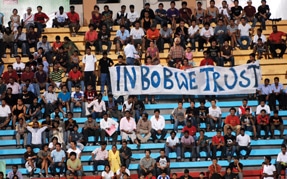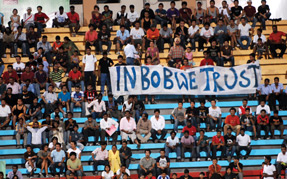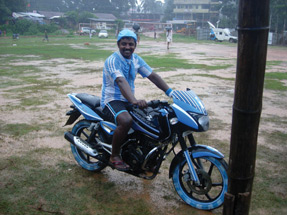Magazine
FIFA Fever In India

In a country where cricket is divine, FIFA fever makes you wonder whether the new generation is headed for a religious conversion.
India is ranked 133 in the world football ranking and the team has no chance of qualifying for a berth in the FIFA World Cup anytime soon. Nonetheless, it ranks third among all countries in online “world cup” searches. There’s an enormous appetite to watch football in the country. A Nielsen Global Online survey reported that half of all Indians claim to be fans and plan to watch the World Cup — the 10th highest in the world.
From southern Kerala to eastern Kolkata to northern Punjab, the country is in grip of football fever. Veteran sports journalist Raja Ramanna says, “Football’s not a sports story at all, it’s a love story, a long distance relationship, which is totally short of any logic behind it, as if any love story has one. For some this love story even turns into a matter of life and death.” Soccer crazy fans in north Malabar, Kerala, had burned down sub-stations for failing to supply them with electricity during the 2006 World Cup. This time they agreed to endure long power-cuts for several weeks preceding FIFA on the guarantee of uninterrupted power supply when the matches were on. Locals have erected larger than life cut-outs of their favorite players on every major crossing in the city. Flags of Brazil, Argentina, France and England flutter atop homes. The city may as well be host to the games. In West Bengal, Mamata Banerjee’s political slogan “Ma, Maati, Manush” (mother, soil, people) has been twisted to “Ma, Maati, Maradona” by fans in Kolkata, the football capital of India. This season, the virus was infused by German legend and FIFA World Cup-winning captain Lothar Matthaus, who kicked-off FIFA fever early in January. The Salt Lake Stadium in Kolkata was packed to capacity and the rest of the city peeked in to catch a glimpse of the Holy Grail of Football.
“Soccer has always been a big passion in Bengal. Whether in office corridors or clubs, everyone can be heard talking about it,” says Kaustuv Ray, owner of a soccer team Chirag United, which plays in the national football league. The City of Joy is celebrating the ball carnival with Disco-Football, quiz shows, tattoos, face paints, etc. The opening day of the World Cup was marked with “infused chilled vodka shots and kebabs marinated with Jamaican rum” at one hotel, which is hosting country themes throughout the World Cup. Cocktails are sold at half price every time a goal is scored. The exuberance of football fans in Margao, Shillong or Kozhikode matches the best in the world. Former Indian striker I M Vijayan, who hails from Kozhikode, claims, “Even a small boy in Kozhikode has views on the prospects of each team.” The state of Goa is painted red and green for its hometown favorite Portugal. “Goa has the Portuguese influence sketched all over — in our houses, lifestyle, dancing, music, and cuisine. Little wonder that our choice of the best football team is no different,” says Savio Messias, secretary of the Goa Football Association (GFA).
But nothing can quite match the fervor of fans in South India. Brazilian or Argentinian fans are promised free auto-rickshaw rides in Malappuram in Kerala. Auto-rickshaw drivers have painted their vehicles in their favorite team colors and are offering fans free rides. “I think Brazil has more supporters than Argentina, at least in Kerala,” says a gleeful Mohammed Ali, whose rickshaw is painted yellow with green highlights. He has threatened to set his vehicle on fire if the Brazilians fail to win their sixth title. New Delhi, which is working overtime to gear up for the upcoming Commonwealth Games, is finding a welcome respite in the sport. George Mathew, owner of Castle 9 and Knight restaurants in Connaught Place, says: “Most tables are reserved in advance during FIFA. We have customers here till 1 am. The sale of beer and appetisers has risen manifold.” Mathew’s restaurants are featuring exciting football-themed menus. Several Bollywood stars are also touting their love for the game and their teams. Actor John Abraham, an avid football fan, says he wants to make a film on every conceivable team in the world. “Let’s see when it shapes up. As of now, I want Argentina to win,” he says. Shah Rukh Khan recently tweeted: “Brazil is my all time favorite, but I also love Germany, Argentina and Italy. Quite a cliched choice I know, but they are all brutal and beautiful.” Bollywood hotties Shilpa Shetty, Aishwarya Rai, Kareena Kapoor, Bipasha Basu and Deepika Padukone have all sworn allegiance to the game. Sanjay Bannerjee, sports journalist and international commentator, says: “Unlike earlier years, today media coverage for football is as vivid and extensive as cricket has been all these years.” ESPN-Star Sports, which is showcasing the 45 matches, estimates overall revenue at Rs 150 crores ($34 million) this year, which is a 300 percent jump over the 2006 FIFA World Cup. “Even before the season kicked-off, our slots were almost sold out. Advertisers in India look upon FIFA World Cup as a seriously effective way of reaching out to their target audiences,” says R C Venkateish, managing director of ESPN.
Even Indian cricket players are smitten. Test match player Ashok Malhotra says: “The 20-20 format of cricket is footballization of cricket. Had the match tenure not been shortened and power-packed, cricket would slowly have lost its No-1 position in India. We may not have a strong football team, but people’s love for the game is strong and undying in India.” His sentiment is echoed by another player Maninder Singh: “In recent years, football sure has become the new favorite of many sport lovers in India. Reason enough for the cricket brigade to work towards rekindling the fire for the sport or in time the gentlemen’s game may lose it to the beautiful game.” Shaji Prabhakaran, ex-director at the All India Football Federation (AIFF), says, “There’s no denying the fact that the craze for football is growing by each passing year. That is precisely because today’s generation is growing up watching the best of football leagues like EPL, contrasting preceding decades when media didn’t give enough coverage to international football.” The Indian media have fanned the debate, questioning the primacy of cricket to the exclusion of other sports in the country. “Brazil’s obsession with football hasn’t prevented them from producing world-class teams in a range of other sports from volleyball to basketball. We have also to create scope and opportunity for other sports to grow in India other than cricket,” says Rajdeep Sardesai, son of star cricketer Dilip Sardesai and editor-in-chief of CNN-IBN News. Mike Rehu, a senior producer for ESPN-Star Sports, says, “We believe that if we keep pushing football to the Indian people, especially with the overexposure of cricket as a game in the market, it has a really good chance of catching the imagination of the public.” In fact, football has long and deep roots in India, predating the game’s popularity in Europe and South America. The Durand Cup (1888) is the third oldest football trophy in the world. Even Spain’s beloved Real Madrid Club — the most successful football club of the 20th century — is far younger than the Calcutta Mohun Bagan Club. In 1911, a team of barefoot natives beat the East Yorkshire Regiment, shooting two consecutive goals in the last few minutes to win the Indian Football Association Shield. Next day, newspapers reported that a standing crowd of more than 60,000 viewers over-joyously sang “Vande Mataram” for a full 90 minutes. India qualified for the 1950 FIFA World Cup, but withdrew, reportedly because the players was not allowed to play barefoot. T Shanmugham, a member of the 1952 Olympic and 1951 Asian Games-winning teams recalls: “The formations have changed since then. We had five forwards, three half-backs and two full-backs. Now, all the teams have strengthened the defence, with four full-backs and four half-backs. Those days we had more attacking football. I used to play center-half.” The 90-year-old still follows the game closely. The World Cup craze has some players pining for a revival of India’s past football culture. Rurka Kalan , an unassuming village in Punjab, is hoping to become the nursery of Indian football players. The Rurka Youth Football Club won the Street Child World Cup Championship, organized in Durban earlier this year. The club was the brainchild of Gurmangal Dass Soni, a young U.S.-based NRI electronics engineer. “This was my way of marking my love for the beautiful game and my wonderful village,” says Soni. Indian football team captain Baichung Bhutia says: “We have a strong craving, the required hunger for football in India. All that is required is a better infrastructure.” |




